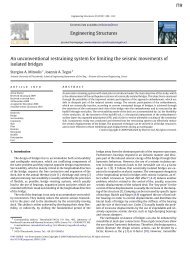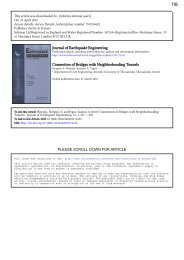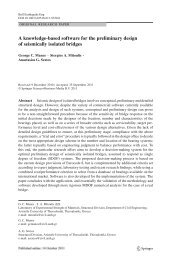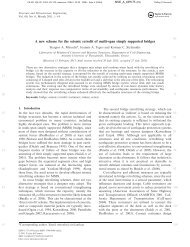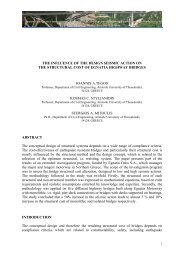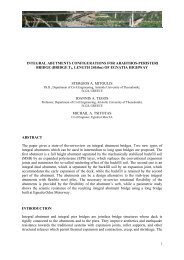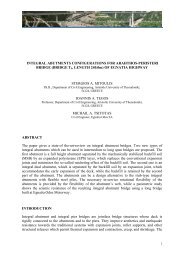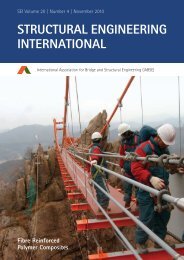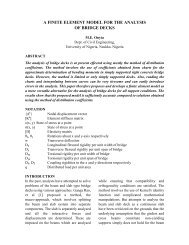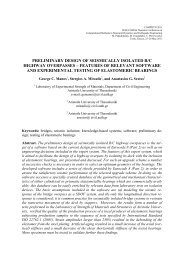18 Preliminary design of seismically isolated RC highway overpasses
Create successful ePaper yourself
Turn your PDF publications into a flip-book with our unique Google optimized e-Paper software.
George C. Manos, Stergios A. Mitoulis and Anastasios G. Sextos<br />
number <strong>of</strong> the longitudinal beams. In the case <strong>of</strong> a cast-in-situ box girder or slab-type bridge<br />
deck, the number <strong>of</strong> bearings per support can be decided by the <strong>design</strong>er as a function <strong>of</strong> the<br />
dimensions <strong>of</strong> the pier’s cap and the anticipated response <strong>of</strong> the <strong>isolated</strong> deck as well as making<br />
use <strong>of</strong> the s<strong>of</strong>tware. As already mentioned, the user can define a minimum and a maximum<br />
value for the compression <strong>of</strong> the bearings or confirm the default range between 2.0 to<br />
5.0MPa. The shear modulus <strong>of</strong> the bearings is automatically set by the program based on the<br />
manufacturer’s specifications or any other experimentally justified value for the case <strong>of</strong> noncommercial<br />
bearings after appropriate testing, as described in section 4.2. It is noted that the<br />
value generally suggested by Eurocode 8 [4] is 1.0 MPa. However, Eurocode 8 also provides<br />
a lower limit <strong>of</strong> 0.9 MPa and upper limit <strong>of</strong> 1.5 MPa to be used in two successive analyses<br />
that can lead to the maximum displacements or the maximum forces <strong>of</strong> the isolating system<br />
and the bridge piers respectively.<br />
(c) Level <strong>of</strong> seismic demand: The user defines the level <strong>of</strong> seismic demand, based on the<br />
elastic response spectrum <strong>of</strong> Eurocode 8-Part 1, the relevant soil classification and importance<br />
factor and a peak ground acceleration <strong>of</strong> 0.16, 0.24 and 0.36 that corresponds to the seismic<br />
zonation <strong>of</strong> Greece; the latter being an open parameter to potentially comply with different<br />
levels <strong>of</strong> seismic hazard in other countries.<br />
5.4 Decision process<br />
The system automatically checks all bearings stored in the database against compression<br />
(through the resulting shear strain in the bearing) and the shear strains produced by the earthquake<br />
loading based on the compression and shear strain criteria described in Sections 3.2.1<br />
and 3.2.2 and then ranks all eligible bearings that have passed the above checks according to<br />
the Optimal Performance criterion. The results are illustrated in a graph, <strong>of</strong> the OP (i) ratios<br />
with the section geometry. The same graph also illustrates the individual safety criterion value<br />
(SC (i) ) and total costs (CC (i) ) in order to facilitate the <strong>design</strong>er when making selections based<br />
on purely safety or cost criteria. The s<strong>of</strong>tware also provides in a tabular form the following<br />
summary results: (a) the maximum displacement <strong>of</strong> the deck subjected to the <strong>design</strong> seismic<br />
action, and (b) the aforementioned safety criterion values, cost ratios and optimal performance<br />
indicators. Apart from the graph and the table, the s<strong>of</strong>tware provides an output interface for<br />
each eligible bearing, showing the main dynamic characteristics <strong>of</strong> the analyzed bridge system,<br />
i.e. the effective stiffness <strong>of</strong> the resulting isolating system, the total weight <strong>of</strong> the superstructure,<br />
the effective period <strong>of</strong> the bridge, the <strong>design</strong> acceleration at the specific period, the<br />
<strong>design</strong> seismic displacement and finally, a video representation illustrating the fundamental<br />
mode <strong>of</strong> the bridge along the longitudinal direction.<br />
5.5 Assumptions and limitations<br />
Τhe simplified analysis performed in the s<strong>of</strong>tware considering the rigid deck model for the<br />
bridge, is applicable when the total mass <strong>of</strong> the piers is less than 20% <strong>of</strong> the total bridge<br />
mass, as prescribed by Eurocode 8. The bridges under <strong>design</strong> should also be straight or have<br />
small curvature in plan and small longitudinal inclination. The developed s<strong>of</strong>tware is not<br />
limited by the choice <strong>of</strong> the deck cross section. The user can employ a default vertical deck<br />
load value equal to 200 KN/m, considering that the used combination <strong>of</strong> loads includes<br />
earthquake loading. Otherwise, the user should input an appropriate vertical deck load value if<br />
the particular deck does not correspond to the default value. The s<strong>of</strong>tware can be used in all<br />
<strong>isolated</strong> bridges with elastomeric bearings. However, the s<strong>of</strong>tware cannot be used in cases<br />
when monolithic pier-deck or abutment-deck connections are combined with seismic isolation<br />
in the bridge. This structural scheme represents a <strong>design</strong> alternative implemented in case <strong>of</strong><br />
16






